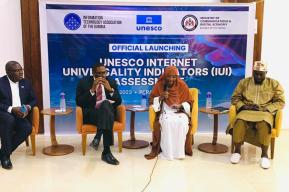Article
IPDC is the cradle of the UN Plan of Action on Safety of Journalists, says chair of UNESCO's intergovernmental body for media development

She highlighted both IPDC’s foundational and its ongoing work in her remarks at the multistakeholder event which was organized by the government of Austria in cooperation with UNESCO and the UN Office of the High commissioner for Human Rights (OHCHR), on 3-4 November in Vienna.
Amb Brandt recalled that the UN Plan had at the outset been conceived a decade ago by media development and governmental experts within in a session of IPDC’s Council members, representing UNESCO Member States. She further highlighted the IPDC’s continued contributions in monitoring, legal support and training since then.
“Accountability for violations against journalists is dependent on data, so monitoring is a key area,” Ambassador Brandt explained. A major addition to this monitoring is the Director-General’s Report on the Safety of Journalists and the Danger of Impunity, as mandated by the IPDC Council, she noted.
“This is a unique mechanism that reinforces the primary responsibility of States for ensuring that fatal attacks on journalists are effectively prosecuted,” said Ambassador Brandt. She alerted that the next Report will be presented at the upcoming IPDC Council session on 24-25 November.
The IPDC Chair also flagged new topics receiving IPDC’s attention such as promoting internet transparency as a means to improve monitoring and responses to online violence harassment; tackling gender-based violence against journalists, especially online; and addressing the needs of displaced and diaspora journalists, in particular on conflict contexts.
Amb Brandt cited a recent project that the IPDC Bureau had approved titled “Supporting media safe spaces for journalists in conflict situations”, which will include a pilot phase in Pakistan - for journalists who have left Afghanistan - and in Ukraine,
“Together we must continue to protect journalists and the media to protect democracy”, she concluded.
The IPDC Chair’s remarks were part of a panel discussion with Nada al-Nashif, the Deputy UN High Commissioner for Human Rights and the Pedro Vaca Villareal, the Special Rapporteur on Freedom of Expression for the Inter-American Commission on Human Rights. The discussion was moderated by Tawfik Jelassi, UNESCO Assistant Director General for Communication and Information.
The session was part of a multi-stakeholder gathering organized to take stock of achievements and gaps in ten years of implementation of the UN Plan of Action, which in 2012 won the endorsement of the UN Chief Executives Board. The Plan has been a frame to coordinate the efforts of both UN actors as well as civil society, policy makers, professional associations, law enforcement actors and academia.
In the pre-conference sessions organized by civil society on 3 November, the IPDC Deputy Secretary, Ms. Saorla McCabe spoke about UNESCO’s work on the development of a possible model protocol for legal measures on the safety of journalists, which is supported by the IPDC. “This work is based on an initiative in Latin America and the Caribbean to develop a Model Law for the safety of journalists.”, she explained. “Consultations are underway about potentially elevating this initiative to a voluntary protocol relevant to all regions, and which could guide specific laws as customized for different parts of the world. ».
In its 10 years of existence, the UN Plan of Action has contributed to the launch of a multitude of networks, and has brought together a wide array of relevant stakeholders to foster a safer environment for journalists and media workers.






